

Waikeria works wonders
By Mary Anne Gill
A Waipā-based contractor has credited the Waikeria Prison redevelopment project with transforming his business and creating dozens of jobs.
JWI Earthmoving, a civil earthworks, concrete and logging company based in Ngāhinapōuri, was founded in 2016. The company was initially subcontracted for a small scope of work at Waikeria, but its role quickly expanded to include site establishment, landscaping, and support services.
Director Jason Inness, who returned to Te Awamutu after working in Australian mines, driving and civil construction, started the project in 2018 with four full-time staff.
Today, JWI employs 45 people30 full-time and 15 subcontractors - drawn from Waipā, King Country, and Hamilton.
The company also provided employment to eight “return to work” prisoners, supporting rehabilitation efforts.
The Waikeria redevelopment
was delivered by CPB Contractors and Pacific Partnership under a Public Private Partnership with the Department of Corrections.
CPB Contractors general manager Paul Corbett said local employment was a key priority, and JWI’s growth was a clear example of the long-term economic benefits regional infrastructure projects can bring.
“We invested heavily in new equipment to meet the demands of the project,” said Inness.
That included concrete plants, excavators, bulldozers, rollers, trucks, and advanced machine control systems.
“These assets have since enhanced our capability and efficiency across other projects.”
Inness said working with CPB Contractors was a turning point for JWI. “JWI has grown from a small-scale operation with limited systems into a well-structured company capable of planning, managing, and executing large, complex projects with confidence.
“Over the past four years, we have developed and implemented





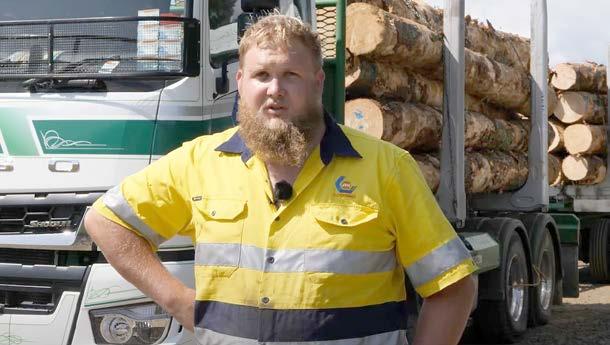
robust systems and processes, including comprehensive quality assurance and cost control frameworks.”
The project helped JWI build its reputation in the civil construction sector and forge relationships with major industry players.
“It has also opened doors to new opportunities and demonstrated that a regional contractor like JWI can perform at the highest level on a nationally significant project,” said Inness.
Whangārei-based McKay, one of the largest privately owned electrical contracting companies in New Zealand, was another to benefit from the project. The company, founded in 1936, was able to use the project to grow its apprenticeship numbers to


60. Managing director Lindsay Faithfull said the opportunity presented growth opportunities for the business and for its employees who worked at Waikeria.
The new 500-bed facility includes a 96-bed mental health and addiction centre, offering enhanced care, education, and training to support prisoner rehabilitation.
The project covers 21ha and includes 28 new buildings, associated infrastructure including perimeter walls and fences, covered walkways and recreational facilities, requiring approximately 8.5 million work hours to complete.
Waikeria Prison sits on a 1200-hectare site on King Country’s northern border, 15km south of Te Awamutu and surrounded by longestablished farms.
It was established in 1910 as a reformatory farm after the government stopped sending offenders to Tasmania.
Six prisoners, one carpenter and three labourers built the prison camp which went on to become the country’s first male borstal in 1925. In 1981, it briefly became a youth institution, but was reinstated four years later as a men’s prison. In 2011 it became the country’s largest prison only to be later usurped by Rimutaka Prison.
Corrections have recruited 300 additional frontline staff while preparations are underway for a further expansion which would add a further 810 beds which, when completed in 2029, would make it New Zealand’s largest prison again.



Waikeria Prison exterior
Jason Inness of Waipā firm JWI Earthmoving.

Chamber take over i-Site
By Jesse Wood






Te Awamutu Business Chamber has taken Destination Te Awamutu under its wing to ensure the continuation of Te Awamutu i-Site Visitor Information Centre.
To the public eye, everything will remain the same.
The reassurance comes after the closure of Cambridge’s centre on June 30 following Waipā District Council pulling funding, cutbacks, a rent increase and Riverside Adventures’ decision to move out of the Town Hall space.
Destination Cambridge, which previously ran the i-Site before handing over to Riverside, has switched to a digital presence.
The Te Awamutu i-Site covers the wider Waipā region.
Destination Te Awamutu. It will still operate as it does now, but it’s under the umbrella of the chamber’s incorporated society. That way, it saves costs.
“Destination Te Awamutu also gets a lot of online visitors. That’s why the business community wants to make sure that when people look at Te Awamutu online, that we’re presenting the best possible face and encouraging people to come.”
Walsh said the chamber doesn’t have money to fund the centre, but they can help Destination Te Awamutu save money and become more sustainable.
Destination Te Awamutu will become a sub-committee of the chamber and remain an i-Site.










Club, Albert Park Drive on Thursday 17 July, 1pm for a 1.30pm start
Guest speaker: Mandy from CommSafe
Door charge $2, usual raffle and cuppa.

“The Te Awamutu Business Chamber believes that Destination Te Awamutu does a job that’s important and everyone benefits from it. Businesses and residential alike,” business chamber chief executive Shane Walsh said.
“Both boards have agreed that we disestablish the incorporated society of
the
“Coming under the umbrella of the chamber saves some compliance costs. The chamber will look after those functions,” Walsh said.
i-Site visitor information centre general manager Harriet Dixon said it makes sense to be linked with the businesses.
Dixon is the only full-time employee alongside several volunteers. Without the volunteers, they couldn’t keep the doors
Listing the catches
While our car crime spree continued last week, we have had another good catch.
A young person was tracked from a stolen vehicle that had been seen being driven suspiciously in Leamington. He was arrested after fleeing from police. He will be facing charges in court accordingly. If your car is stolen, or attempts are made to get into it or steal it, please report it to police as soon as possible.
Still talking youth, five young people were apprehended having forced their way into a commercial storage building on Queen Street. All have been referred to Youth Aid. In other news, a female was caught driving whilst her driver’s licence was suspended. The vehicle she was driving was impounded and she too will be appearing before the courts. A serious assault in Leamington resulted in a male being arrested and charged. Another male was found to be breaching bail and in an intoxicated state on Victoria Street. He was arrested and held in custody to appear in court the next day.
In all cases brought before the courts, whether youth or adult, if released on court bail, they will be subject to conditions by which they will need to abide. When adults breach their bail conditions, they may be arrested immediately. Repeatedly breaching bail may result in bail being opposed and the
Curious about a Career in Real Estate ?
Do you love meeting
Would you be driven by the idea of
offenders remanded in custody.

Finally, we continue to receive reports of people being scammed in different ways. Scammers are sophisticated in their methods. If you are on Facebook and receive a friend request from someone you know, but with whom you are already friends on Facebook (a duplication), do not accept. If you are messaged any links, even if they appear to have come from one of your Facebook friends, do not click on it without contacting them directly offline first. This is especially the advice if the message seems out of character.
We had a report this week of a Facebook scammer advertising a large item on Marketplace and completing a sale. When the victim went to collect the item, the legitimate owners had no idea what she was talking about.
Unfortunately people advertising items for sale that they either don’t actually own or never even existed (outside of a photo) is not uncommon.
As I always say, pay only upon collection of a marketplace item, especially if it is high value. If you transfer money - even a deposit - sight unseen, you risk losing your money. This in turn motivates the scammers to continue on.

“We are promoting local businesses and encouraging people to come to the town,” Dixon said. “This is a way to cut our outgoings. As a not-for profit, it’s important that we’re careful with our money and this is a way to be able to do that.”
At present, funding comes via instore souvenir retail, hiring out the Burchell Pavilion and the Rosetown Monthly Fair. Walsh said the Te Awamutu community need their i-Site.
“When the council cut funding, the community said, we’re going to start a petition. We have all these signatures of people who want to keep it open. We’re responding to that. The community has given a strong signal,” Walsh said.
“As the chamber, we’re going to use our knowledge and skills to help Destination Te Awamutu become sustainable.”



On
beat with Senior Constable DEB HANN
The Te Awamutu Business Chamber want to ensure the continuation of the Te Awamutu i-Site Visitor Information Centre. open.
Pre election reports
Hamilton city, Ōtorohanga and Waikato district chief executives have published their three-yearly preelection reports under the Local Government Act. The reports offer potential candidates a look at the key issues, priorities and the councils’ future direction.
Waipā and Waitomo are expected to publish their reports soon.
Calling for candidates
Nominations for the October local body elections have opened. No special qualifications are needed to run and anyone who is a New Zealand citizen, aged 18 or over and enrolled on the electoral roll, is eligible to stand for district and regional councils. Nominations close at 12 noon on Friday, August 1. Local elections will be held by postal vote, with voting papers sent out from Tuesday, September 9. Election Day is Saturday, October 11.
Good Local expands
The publisher of the Waikato Business News and three weekly community papers – Cambridge, Te Awamutu and King Country News –has added a fifth masthead to the family. Good Local Media owner David Mackenzie has completed the purchase of the Bay of Plenty Business News. He made the announcement soon after Stuff revealed the Cambridge Edition community newspaper would be one of several mastheads to close.
Cutting in Pak’n Save Te Awamutu staff
Adrianna Te Aonui and Cody Burbery will compete in the finals of the Young Butcher and Anzco Foods Butcher Apprentice of the Year next month. Te Aonui was named Waikato young butcher of the year and Burbery won apprentice butcher of the year at heats in Te Awamutu.
Call to stall all waste incineration
By Chris Gardner
Don’t Burn Waipā spokesman Eoin Fitzpatrick wants a moratorium on waste to energy incineration pending a national analysis.
Fitzpatrick made the appeal to the independent Board of Inquiry hearing Global Contracting Solutions application to build the Paewira plant in Racecourse Road, Te Awamutu, as well as national regulator the Environmental Protection agency.
“I am not sure if the board or the EPA has any say,” Fitzpatrick said last Thursday – the penultimate day of the three-week hearing in Hamilton. “But I would also like them to recommend a moratorium is put on waste to energy incineration until a national analysis has been done so as to prevent other small communities going through what we have been through.”
Fitzpatrick, who has lived in the town for 20 years, urged the board to decline the application “for what I believe to be a plant in an entirely unsuitable location by an applicant who I believe simply wants to be in control of the process of getting rid of their toxic waste without proper oversight.”
The site is near the Mangapiko Stream, Te Awamutu’s Fonterra dairy factory, Waipā Racing Club, Te Awamutu College and the national headquarters of Te Wananga o Aotearoa.
During the course of the hearing Fitzpatrick said he had become more concerned with the applicant’s ability and willingness to comply with good practice, standard operating procedures and regulations.
“I have more concerns about the ability to manage the feedstock,” he said.
Earlier in the week Te AwamutuKihikihi Community Board deputy chair Kane Titchener took the community board’s objection to the board of inquiry.
“The board is opposed to the incinerator going ahead,” Titchener said.
“This includes not only the current location but also any location in the Waipā or Waikato due to the potential plume drift.”
Titchener was concerned with dioxins entering the food chain.
“The proposed technology is new to New Zealand. The public will be reliant on the company to monitor and control emissions, and we will have no idea if they are doing it properly or not. The risk is too high.
Internationally such plants are seen as old technology, and the harmful toxic effects are evident,” he said.
The visual impact of the proposed plant would be totally unacceptable

and devalue all properties in Te Awamutu Titchener said.
“No-one wants to live near an incinerator that is emitting dioxins and nano-particles into the air.
Linking homes of champions
By Chris Gardner
When the Kenyan High Commissioner to Australia Dr Wilson Kogo drove through Te Awamutu in February, he said it would make the perfect sister city to the Kenyan city of Iten. Both market themselves as the home of champions.
Rowing and cycling in Waipā, long distance athletics in Iten.
Kenyan born Waipā dairy farmer Charles Anainga and his wife Ann-Marie agreed with the commissioner and took the idea to Te Awamutu-Kihikihi
Community Board in June supported by deputy mayor Liz Stolwyk.
Kogo had visited Stolwyk’s Ōhaupō dairy farm in February to learn about New Zealand dairy farming.
“He was quite impressed with agriculture,” said Charles Anainga, president of the Kenyan community in New Zealand.
“What we really see, and think is that Kenyan culture could be a culture that comes into New Zealand in a way that the Filipino culture has come
into New Zealand,” said AnneMarie who met Charles during her OE in Kenya in the 1990s.
She saw opportunities for the rural communities in both Te Awamutu and Iten to connect online and share knowledge.
The pair married and, after a short stint in the UK, came to New Zealand about 25 years ago.
They have been dairy farming for 20 years, most recently at Whitehall, and Charles is a member of the Ōhaupō Ngāhinapōuri Lions Club.
Community board deputy chair Kane Titchener said the idea needed community backing to ensure it was successful.
“We don’t want to go into something without that support,” he said.
“It’s early days,” said Stolwyk of the proposal.
“The green light needs to come from the community board, but it does present a nice opportunity.”
A community barbecue for interested parties was suggested.

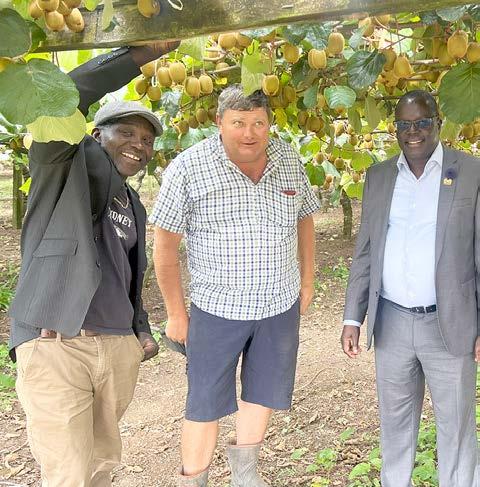
Funeral Director: Jordan Goss
Waipā dairy farmer Charles Anainga, left, with Te Awamutu Federated Farmers chair Andrew Reymer, centre, and Kenyan High Commissioner to Australia Dr Wilson Kogo.
Kane Titchener
AGE OF REASON
Time to get interested
By Peter Carr
I looked back at the weekend, to July three years ago, when I kick-started my Opinion runup commentaries on the forthcoming local body elections.
At that time (mid-July) there were two aspirants for the mayoral roles – which later became four, although the third and fourth were never a real starter. One certainly disappeared fast once the voting was over. The successful candidate essentially trumped a very longstanding and loyal mayor (and local body officer) and more on her later.
Now, early in the campaign, it appears that we have three people keen to take up the mayoral chains and one must ponder what it is that drives people to put their family and professional lives on hold to serve a population that, in the main, cannot be bothered to vote.
This time around there is a more professional feel to the race. Two long-standing councillors, clearly dissatisfied with the way that the Waipā council is performing, seek to steady the ship onto a more meaningful course. It is no coincidence that they will be, in part, driven by a staggering upcoming rise in residential rates –and also feeling guilty regarding what appears to be some secretive meetings behind closed doors.
Another regular opinion writer (an economist) last week bemoaned not only the rates increase but the fact that the number of council employees has risen over the past three years by a staggering amount. Was this management at fault with the previous chief executive – and, moreover, to what extent is the governance (elected) body doing to keep possibly unwarranted employment excesses in check? I am not commenting on the why/ reality as I am not close enough to express a worthwhile opinion, but election time is always
a good opportunity to flush out the facts.

I hear that there is dissatisfaction around the top table regarding leadership capability and perhaps high-handed treatment of some of the elected representatives. The withdrawal from Waipa council of a longstanding mayoral deputy speaks volumes in itself. The timing is not just a coincidence. But the current incumbent at the top has every right to explain how she perceives the way forward under the guidance of a relatively new chief executive.
There are some heavy-hitting items on the table this time around. The waste disposal (by conflagration) proposal for siting in Te Awamutu, the ever-moving ‘blue blob’ that denotes possible forced purchase of third bridge-related access and egress roads, the desire of quarry operators to wreck the roads in the Cambridge CBD – and the huge expansion of residential housing on prime agricultural land that is responding to the rapidly growing demand for residences in Cambridge.
We will soon be besieged with pamphlets, hoardings, public meetings, claims to be the saviour of our collective futures – many from people who are clearly ill-fitted for the roles. That said there are also good people out there who deserve to be listened to in a fair-minded and even-handed manner.
If we all took some time to study the form, attend public gatherings to directly take on board aspirants’ ideas, we then have the opportunity to form a balanced and worthwhile viewpoint. Just sitting on the sidelines and leaving the decision-making to a minority is just not good enough. For goodness sake people –listen up and then vote.
The demise of Alfred Jones
By Meghan Hawkes
About four miles out from Pokuru near the Te Mawhai station road junction on an August evening in 1925 two motorists passed a strangely stationery car.
The door was open, the engine was running, and the headlights were on but there was nobody about.
The next morning the Waipā County road superintendent Mr Westbrook saw the same car on the side of the road and stopped to investigate.
He was horrified to find the body of 44-year-old Alfred Jones underneath it.
The police were called and Constable Doyle, along with Dr Hall, hurried to the scene, arriving about 7.30am.
The crank handle was in the car, the throttle open to almost its full extent, and the car was in low gear with the brakes off.
It seemed Alfred had experienced car trouble and had got out to crank the car, leaving the engine in gear.
It appeared that as the crankshaft connected the
car had jumped forward, knocking Alfred down and going over him. The doctor found that life had been extinct for several hours.
Alfred, from Tasmania, was well known throughout the Waikato and had resided in the district for nearly 20 years.
He had been chairman of the Kakepuku Dairy Co, and in addition to his farming operations conducted a land agency.
He formerly lived at Pirongia, running a butchery business, but during the war he negotiated many sales of farm property in the neighbourhood of Te Awamutu.
He then decided to live on his partly improved farm at Pokuru but continued his land agency business in Te Awamutu, travelling back and forth each day.
He was on his way home when the fatality occurred. He had a wife, Rhoda, and several children.
Tragically four years previously their youngest son, six-year-old Lloyd, had died.
Now, the news of

Alfred’s death came as a shock to his large circle of friends and acquaintances.
At the inquest the two Pokuru motorists who passed the car said they assumed the driver had temporarily left the vehicle. The night was very dark, and they would not have noticed the car at all but for the sound of the engine and the glaring headlights. Other wayfarers were believed to have also passed the car later, but that by that time the engine had stopped.
Dr Hall said Alfred had met his death by suffocation and heart failure; death probably being instantaneous. The coroner returned a verdict in accordance with the medical evidence. Alfred was buried at Te Awamutu cemetery where his son was also buried.

From 1 July 2025
Call to save town reserve
By Chris Gardner
Waipā District Council is being asked to abandon plans to sell Arthur Patterson Reserve for the building of three or more houses and reinstall a slide and swing there.
Submissions on the council’s plans to revoke reserve status on the 2100 square metre green space for disposal closed last Friday.
The reserve is named after a former Te Awamutu Borough Council member and deputy mayor who spent his honorarium on planting productive trees. Some of his walnut trees remain in the reserve.
“It sucks, major time,” said Eden Avenue resident Shana Sanderson of the council’s plans. “I would like to see the slide and swings reinstated.”
Both of her school aged children play in the reserve regularly, and the family walk its dog there.
Another resident, Joel Impey, said the reserve was popular with dog walkers.
Te Awamutu-Kihikihi
Community Board member Jill Taylor and Te Awamutu councillor Lou Brown met
Taylor is asking for the slide and swing to be reinstated.
“Residents wish they had not been removed, and they should be replaced so the children in the area can use again,” Taylor said.
“Even plant some more fruit trees for the locals. It is not a huge area and not satisfactory to build on without a huge cost in infrastructure.”
Brown said the council should take a second look at the proposal to sell.
Access to the reserve, which has no services such as electricity or water, is about four metres wide.
Patterson, who died in 1993, served 26 years as a councillor on Te Awamutu Borough Council, the last 12 as deputy mayor. He was involved in Te Awamutu Rotary Club, Te Awamutu Chamber of Commerce, Te Awamutu Competitions Society and Waipa District Scout Association.
His daughter Clare Harris, of Te Awamutu, has written to the council objecting to its plans. She also supports the reinstatement of a slide and swings.

They use it quite a lot. They have to retain it.”
Her brother Alan Patterson, who also lives in the town, also objects to the redevelopment.
“Dad would be disappointed that nearly all of the trees that he planted around town have gone,” Patterson said. “That’s what he thought his legacy would be.”
The siblings have written to the council objecting to the reserve’s disposal after hearing about the plan from a friend who had attended a council meeting.
“They never approached us, just iwi,” Harris said.


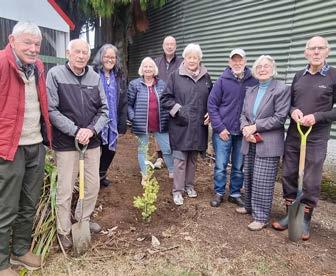
By Chris Gardner
The work of Pirongia Heritage and Information Centre foundation and life members the late Murray Walter and his wife Barbara has been recognised with the planting of a golden totara.
The tree was planted at the centre by the Pirongia Heritage and Information Centre committee last month to celebrate the Walters’ contribution.
The couple were involved with the moving of the old St Saviour’s Church, once sited on the Alexandra Constabulary Redoubt on Bellot Street, to its present site at 798 Franklin

















Arthur Patterson.
Pirongia Heritage and Information Centre members plant a tree commemorating the work of the later Murray Walter and his wife Barbara. The committee, from left to right, is Nick Van der Sande, Charlie Coles, Te Mihinga Komene, Ros Empson, Buck Macky, administrator Jenny Mortland, Brent Mealing, Marilyn Yeates, and groundsman Robert McWha.
ON SHAKY GROUND
Explosive eruptions
By Janine Krippner
It’s the time of year again when I am spending a month working in the Canary Islands, located offshore northern Africa but part of Spain. I am working with GeoTenerife for the third year, a group dedicated to addressing local geological challenges—most notably, helping communities prepare for future volcanic activity.
One of the most rewarding aspects of this work is mentoring students and watching them grow into experts. I learn just as much from them as they do from the experience. They go on to become the experts in their fields, pushing the boundaries of science in volcanology and other fields.
This year, I’m working alongside Ethan Hamilton, a Master’s student from Ireland who interned with the programme two years ago. Now, he’s researching explosive eruptions from Tenerife’s complex volcanic past.
While the most likely future eruption here would be relatively small -producing lava flows, volcanic ash, and maybe a new scoria cone (similar to what we could see in Auckland’s volcanic field) - it’s important to also understand the larger, more explosive eruptions and their potential impacts.
Ethan’s work provides a great opportunity to share what this type of research involves. He’s been traveling around the island documenting pumice deposits - light, porous volcanic rocks formed during explosive eruptions like we see around Taupō and Rotorua - from dozens of past events.
To start, he has driven around the island and found outcrops – places like roadcuts
Durham University, and he spends time at each location taking careful notes on what he sees.

He uncovers clues given by the thickness of the deposits across the region, the patterns and variations within the deposit, and how different deposits relate to others across the landscape.
Ethan also studies the pumice clasts themselves, examining their size, shape, and the number of gas bubbles trapped as magma rose and exploded. He also notes the minerals that formed as the magma cooled, all of which reveal details about eruption dynamics.
Mixed within the pumice are lithicsfragments of older rock torn from the volcanic conduit or surrounding land during the violent eruptions. These usually appear as darker chunks within the lighter pumice and can include bits of older lava flows or deeper rocks like granite, which formed as magma cooled underground. The types and quantity of lithics offer insights into the eruption’s violence and the landscape it passed through.
The relationships between different deposits - for example, one sitting on top of another - help reveal the island’s volcanic history. But pumice fall deposits are tricky: they come from ash plumes carried by wind, so they’re not evenly distributed and may be missing from some areas due to erosion.
Through this detailed work, Ethan aims to build a more complete eruption history of Tenerife, just like volcanologists do across our own volcanic landscapes.



Celebrating youth
By Julie Guest
As I write this, I’ve just finished helping run a holiday programme for primary school children at St John’s, and my heart is full.
In my role as vicar, I’m blessed to spend regular time with young people, and what strikes me most is how amazing they are, compared to the narrative we’re often presented.
Today’s young people are growing up in a world that’s almost unrecognisable to those of us in the second half of our lives. They live with news of wars, climate catastrophe, and social upheaval. The future that seemed so exciting to previous generations feels fragile and uncertain to them.
Yet despite this, what I see are young people who are thoughtful, creative, and caring.
We hear so much about children being “glued to screens” or “lazy” or “disrespectful.” But even if they stepped away from their devices, would much really change for most of them? The challenges they face would remain the same – they’d still be navigating a world that feels increasingly dangerous and unpredictable.
The truth is, there are thousands of ordinary young people who are actively generous and kind. They care for siblings, they help out at home and in voluntary clubs, they support friends through mental health struggles, they are imaginative, funny and vulnerable. But we rarely hear about them. Instead, we see either the very worst or the outstanding young people, missing the beautiful, complex reality of most.
Young people thrive when adults will sit with them, listen to their concerns about the future, celebrate their achievements, and help them navigate the complexities

of growing up in 2025. Christians can offer something even more powerful – the truth that allows thriving even against the odds. We can share the news that each child is loved by God, completely and unconditionally. When young people can believe that there is nothing they can do to make God love them less, and nothing they can do to make God love them more, something remarkable happens.
Life is no longer a treadmill of trying to earn approval or avoid rejection. Instead, there is an invitation to live freely into your gifts and passions. And when young people are free to be authentically themselves, all of society benefits from their creativity, energy, and unique perspectives.
Churches can be powerful spaces where generations connect. As Christian adults, we have the privilege of showing God’s love through our words and actions. When we treat young people with genuine respect, when we listen without judgment, when we celebrate their successes and support them through struggles, we demonstrate the unconditional love that God has for each of them.
Rather than lamenting how different young people are today, perhaps we should celebrate it. They’re adapting to a world we’ve never had to navigate. They’re developing skills and perspectives we desperately need. They’re showing us new ways to build community, express creativity, and care for our planet. Over the school holidays maybe we can look for ways to connect with the young people in our neighbourhood.


The 40s – in Betty’s words
By Karen Payne
Betty Ross was just 20 when she began her diary in 1940s Cambridge.
She wrote of her volunteer work, news from family and friends and her social life.
When Cambridge Museum staff heard about Betty’s diary from her daughter-in-law Sue Peake, we offered to transcribe it to preserve as an archive.
We discovered a unique insight from a demographic that is rarely heard in war accounts: that of a single young woman living in a country town half a world
away from the action.
Betty was born in 1922 and was 17 when the war began. A typical teen, she was at an age when socialising with other young people was an important focus in her life. And this at a time when most young men in the area were sent overseas.
For a year from June 1942, New Zealand became an important US military base in the Pacific. At any one time, around 50,000 American servicemen were living in camps, including near Cambridge. Betty’s writing is threaded with contemporary slang picked up from the servicemen,
and from the ‘flicks’ showing at the local cinema.
Betty’s son David Peake keeps the diary as a treasured family heirloom but recognises the importance of preserving its contents for future generations.
Betty passed away in 1992, but her words live on as part of “Doing Your Bit” – an exhibition on Cambridge’s contribution from home during World War II.
The museum offers access to two different scanners as part of a free service to encourage people to scan and share family documents.

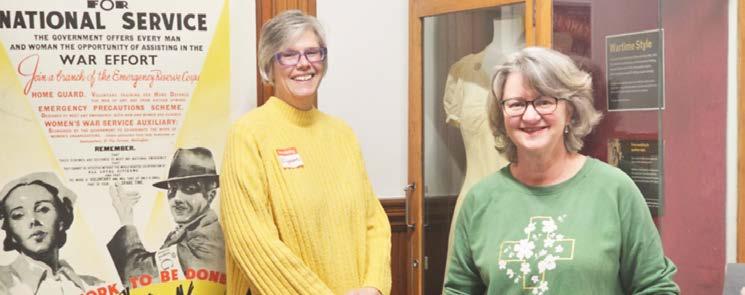
Nothing to do
Betty Ross was 17 living in Cambridge at the start of World War II and started a diary four years later in early 1943. Cambridge Museum has transcribed some of the diary starting with the first entry.
“Whoever reads this. Do so at your own risk!! And please no comments on bad spelling etc.”
Mar 1943
“A Farewell Dance in town hall, 10 chaps. I wore my blue net evening frock. Beverley & Pam Rishworth on door with me. Joan & Rosamond Graham relieved us after a while. Six Yanks in Guard of Honour. They didn’t dance though, worse luck …”
March 1943: “One of the Yanks asked Joan did her eyes bother her – but she knew the answer. You should say ‘No”. They say –‘They do me!’ Cute, what! … They sure were a great lot.”
Aug/Sep 1943: “We are all very annoyed with Pop. We were listening in to a concert relayed from a camp and were enjoying it. He … switches onto stinking old Parliament, stuttering old Pete Fraser etc sending over some awful piffle.”
19 Sep 1943: “I had a fit of the blues that afternoon, things certainly are not much just now. The war looks as though it’ll just go on & on & there’s nothing doing in the village, it’s enough to make one fed up. Oh, for a camp!!”
26 Oct 1943: “Yesterday butter rationing came into force, so we decided that while we had a bit in the house we’d do some baking for the boys overseas. Did some peanut brownies, coconut buttons, and Queen cakes.”

Betty Ross at a Military Ball fundraiser in 1941.
Photo: Cambridge Museum
Cambridge Museum manager Elizabeth Harvey, left, and administrator Karen Payne inside the Doing Your Bit exhibition.
Photo: Mary Anne Gill
Letters to the Editor
• Letters should not exceed 200 words
• They should be opinion based on facts or current events
• All letters to be emailed to editor@goodlocal.nz
• No noms-de-plume
• Letters will be published with names
• Please include full name, address and contact details for our records only
• Letters may be edited, abridged, or rejected at the editor’s discretion
• The editor’s decision on publication is final.
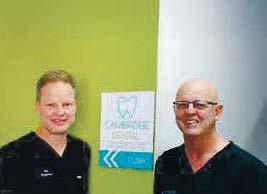




Maths help equals 1000
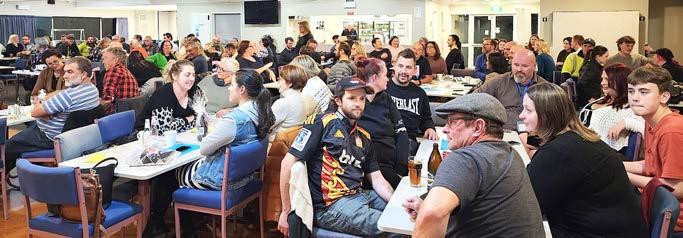
By Jesse Wood
A charitable trust has hit a milestone, helping more than 1000 children from lowincome families with maths.
Eight years ago, Te Awamutu-based Mathematics for a Lifetime chairperson and founder Jean McKenzie recognised a need.
McKenzie said there was no accessible support system for students from financially stressed families who were falling behind in maths.
“I knew of people who would like access to that sort of support and weren’t able to get it. Using our criteria we are targeting people who otherwise wouldn’t have an opportunity to get that help,” McKenzie said.
“It’s very overwhelming and incredible to reach this
milestone. There’s a lot of people that have been on the journey to this stage. We have an outstanding board in place and there’s been other board members that have been part of that.
“We aim to transform lives, giving children an opportunity to change their path. Often for the first time in the family, they’re changing the path that has happened for generations.”
Trust administrator Narelle Brooks said although 1000 students have received direct support, the web of help is estimated to have reached as many as 5000 people.
The trust has two branches of support. In-person tutoring and online math courses for rural schools.
For tutoring, students’ families must earn under $65,000 a year and there must be family support to ensure consistent attendance. The trust has approved tutors in Hamilton, Cambridge, Te Awamutu and Kerikeri.
Their goal is to become national, as it’s a one-of-akind trust in New Zealand.
It’s not just about math. It’s about using the subject as a tool to empower young people and give them the confidence for life.
Students become passionate about math and help family members and friends with their learning.
“The kids come in needing math assistance, either filling in the gaps in their math education or we do extension work when they’re wanting


to drive and push themselves a little bit further,” Brooks said.
“Math is the tool, but what’s really amazing is that it helps the kids with their mental health and well-being. We’re breaking down barriers and creating opportunities, confidence and resilience.
“Then they’re able to put their hand up in class and ask a question, because they’ve got more confidence, and take on other challenges in their life that they thought they couldn’t do.”
The trust has won several business awards, proving their sustainable model.
They have partnerships with the Gallagher Charitable Trust, Glenice and John Gallagher Foundation and Waipā Networks, as well as many significant sponsors such as DV Bryant Trust, businesses and individuals.
“We don’t work in isolation, it’s a very big circle in partnership with Waipā Networks, Gallaghers and all the other individual funders too. It’s them and then us coordinating things. It’s like a big circle and the child is in the middle,” McKenzie said.
“But not only that, it’s all our support people, like my husband.
“Our partners and sponsors have been really impactful on the ability to have the growth that we’re looking for. The generosity has been incredible. They’re making a massive difference to children within the community.”
Sponsors receive reports
each term about children they support, including academic progress, emotional development and photos.
This helps them see the impact of their contributions.
The trust is opening doors for children’s futures, at school and upon graduation, but they couldn’t have done it without community backing.
“It’s about the flow on effect. Start with the child and it goes to the family and that leads to the communities. It goes back to that old saying, when individuals do better, communities do better,” Brooks said.
“There’s a lot of emotion behind it; it’s not just math tutoring. We can only keep doing what we’re doing if we have the support of the community.”
A mix and mingle event will take place in August to celebrate the 1000 student milestone and to thank everyone involved.
Former All Blacks coach Ian Foster, an expert on resilience, is the guest speaker.
“Ian has already been to one of our main events. We have a quiz night that we do each year. He’s good friends with one of our board members Graeme Foote,” McKenzie said. “He immediately said that he would be very happy to take the opportunity to come and support us on this occasion.
“It’s very exciting to have someone of his calibre to come in, recognise what we’re doing and happily speak at our event.”








Mathematics for a Lifetime charitable trust host a quiz night annually to raise funds.
Photo: Supplied























































young at heart
Aligning your lifestyle
Choosing a retirement village that suits your needs in Waipa is an important decision that involves more than just finding a comfortable home. It’s about selecting a community and lifestyle that matches your health needs, financial situation, and personal preferences - both now and into the future.
New Zealand has taken to the retirement village concept like a duck to water and as an industry in just about every town, now offers a wide range of options, from independent living units to fullservice care facilities.
When first looking, the overriding point is consider your ideal lifestyle. Do you want to live close to amenities, close to family, or near a park or other visually stunning location?
Some prefer a peaceful rural setting, while others want the buzz of an urban village atmosphere near cafes, shops, and medical facilities.
Many retirement villages are designed with lifestyle in mind, offering amenities like communal lounges, libraries, fitness centres, and landscaped gardens. Make sure the village aligns with how you want to spend your time - whether that’s joining clubs, gardening, swimming, or simply relaxing in a quiet space. It’s also essential to think ahead. Even if you’re fit and independent now, your needs may change over time. Some offer “continuum of care” options, allowing residents to move from independent living to assisted living or rest home care without having to leave the village. Look for villages that provide on-site healthcare or have partnerships with local medical providers. Ask about emergency response systems, nurse availability, and procedures for changing care needs if you think this will be a necessity in the short to immediate term.


















Understanding the financial model of a retirement village is also vital and you really need expert advice with this – and involve your family. Most villages operate under a licence to occupy (LTO) model, which means you pay a lump sum for the right to live in the unit, but don’t own it outright. There are also weekly fees for maintenance and services. When you leave, a deferred management fee (DMF) - usually around 20–30% of your initial payment - is deducted, although this is coming under increasing scrutiny from the government and may well change. Be sure to get legal advice and read the disclosure statement carefully before you sign on any dotted line. As always, the small print will be the kicker. Compare what’s included in the fees: some villages bundle utilities, rates, and insurance, while others charge separately. Every village has its own culture,












shaped by its residents and staff. Visit several to get a feel for the atmosphere. Are people friendly? Is there a diverse range of activities and events? Talk to current residents to hear their experiences. Some villages have religious or cultural affiliations, which may be important to you.
Also consider the rules - some are pet-friendly, while others aren’t; some allow grandchildren to stay overnight, others limit visitors. Retirement villages are regulated by the Retirement Villages Act 2003. Make sure the village is registered and follows best practices. The Retirement Villages Association of New Zealand (RVA) accredits many reputable operators.
Either way, it’s not a decision to enter without careful research and consideration, but if you do, it can be a fabulous experience as you enter your twilight days.

Young at heart — and wise enough to plan ahead
Enjoying your retirement years is about living well – and thinking ahead. Planning your funeral now means your wishes are known, and your loved ones won’t have to make difficult decisions during a time of grief. At Rosetown Funerals, we’re here to help make those conversations easier. Start the conversation today – visit or call our friendly team at Rosetown Funerals.
07 870 2137 262 Ohaupo Road, Te Awamutu office@rosetown.co.nz www.rosetown.co.nz

Being guided through the health system
New Zealand’s health services offer a wide range of support for seniors to help maintain their health, independence, and quality of life – more than many seniors realise sometimes.
As people age, access to reliable, affordable, and culturally appropriate healthcare becomes increasingly important – but with increasing GP shortages in rural and regional areas in particular that mean a doctor’s visit could be a month away, it’s important to know what else is available.
Most seniors access healthcare through their local GP, who can provide diagnosis, referrals, and ongoing care for chronic conditions like diabetes, heart disease, and arthritis.
While visits usually involve a payment, seniors with a Community Services Card or High Use Health Card can receive significant subsidies, reducing the cost of doctor visits and prescriptions.
But it’s not the only avenue a senior can use.
Seniorline, contracted by Health New Zealand Te Whatu Ora to provide an information service to assist older people to navigate the health system, can be a lifesaver.


Waikato’s Largest
Some of what it provides information on are:
• how you can get help to stay living at home for as long as possible
• support services for carers
• the process for entry to rest home, dementia or hospital care
• funding and the services that should be provided.
Support services for older people are funded by Health NZ, if you are eligible for public health care.
One of the things seniors benefit from are capped prescription costs
– this comes into being after 20 subsidised items per family each year, meaning further prescriptions are free.
Most over-65s also qualify for the Community Services Card, which lowers the standard $5 prescription charge. Pharmacies may also provide free medication delivery and medication packs to make daily routines easier.
Older people who need help at home may qualify for Home and Community Support Services through Te Whatu Ora, after an assessment is organised by their GP. These services include personal cares (like bathing and dressing), household help, and meal preparation. The needs
Specialist Eye Clinic & Hospital

Our team of highly quali ed and experienced Ophthalmologists have many years of fellowship training in their area of expertise.
We pride ourselves on being able to o er our patients a comprehensive range of diagnostic, management, and treatment services inhouse at our clinic alongside our purpose-built Day Surgery – Bridgewater Hospital which is on the same site.
From the rst visit to our clinic, throughout your whole treatment journey with us, your care will be of the highest standard.
If you have concerns about your eye health please chat to your optometrist or GP, they can refer you to one of our specialists for your particular needs. Or you can get in touch below.
Our specialists can help with the following
• General Ophthalmology
• Cataract Surgery
• Strabismus
• Medical and Surgical Retina
• Pterygium
• Uveitis
• Oculoplastic & Lacrimal Surgery
We are an a liated Southern Cross provider, and can assist with prior approval for surgeries if needed. We are also able to see ACC cases, these do need to come with a letter of referral from your GP.


assessment, initially booked by your GP, is done by a local NASC (Needs Assessment and Service Coordination) agency contracted to Waikato Hospital under Te Whatu Ora.
Seniors receive free treatment in public hospitals for medically necessary procedures, including surgery and rehabilitation. Specialist care - like physiotherapy, hearing, eye services, and geriatric assessments - is also available via referral. Wait times can vary, but urgent needs are prioritised.
With many seniors known to have depression, mental health support is also available, with free or low-cost counselling services offered through GPs, community health centres, or organisations like Age Concern and Lifeline. There is specialised support for dementia and
Alzheimer’s, including memory clinics, day programmes, and caregiver support.
When living at home is no longer safe or practical, seniors may be assessed for subsidised aged residential care, such as rest homes, hospitals, or dementia care units. Funding support is available based on income and assets.





Living well within your means
Making ends meet is perhaps more challenging than it’s ever been, with more than 60% of pensioners living either solely on the Government pension, or with a small cash reserve. However, with careful planning, knowledge and access to available support, and a few smart lifestyle choices, it’s possible to live well on the fixed income that is the pension.
The trick is to find a balance between managing daily expenses, staying active in the community, while still enjoying a meaningful life in retirement.
The NZ Superannuation payment is a nonmeans-tested government pension available to those aged 65 and over who meet residency requirements.
While it provides a basic income, many pensioners supplement this with savings, parttime work, or investment income. Some continue working in reduced roles to stay both financially stable and socially engaged.
The Government also allows pensioners to earn additional income without affecting their Super payments, although some of the add on, such as accommodation or living alone allowances can be discounted or removed.
Living within a pension does mean being conscious of where your money goes. Budgeting tools from organisations like Sorted.org.nz can help track income and expenses. Seniors often find savings by downsizing their homes, switching to more affordable power and phone plans, and taking advantage of discounts and loyalty schemes.
The SuperGold Card offers free off-peak public transport, and there are discounts at many businesses across New Zealand, from cafes and retailers to dentists and mechanics.

For many pensioners, housing is the largest cost. Those renting may be eligible for the Accommodation supplement, a payment to help with rent or board. Homeowners with low income can apply for the Rates Rebate Scheme, which reduces council rates. Some councils also offer postponed rates or senior housing with subsidised rents, although the market-rental drive being implemented by many councils these days is making it much harder for seniors to live alone.
It’s worth checking these options through the council, or the Work and Income website. Most seniors are eligible for subsidised healthcare, but additional costs for prescriptions, dental care, and glasses can add up.
The Community Services Card lowers costs for doctor visits and prescriptions, and many over65s qualify. Local organisations such as Age Concern and Presbyterian Support, also offer help with household tasks, transport, and social connection - reducing costs and supporting wellbeing. You can also have your doctor organise an assessment for home help where needed through Te Whatu Ora.
Shopping wisely can make a big difference. Buying seasonal produce, shopping at


farmers’ markets, and using loyalty cards (like Countdown’s Onecard or New World Clubcard) can stretch the grocery budget. Some community centres run free or low-cost meals, and organisations like Salvation Army or local food banks offer support during hard times. If you like to grow your own and want to share, set up your social network to help out or check with Grey Power or Age Concern – or your local church. Often these organisations know who needs what help.
For those who like the coffee culture, or going out for lunch, often this is the first activity to become limited, or becomes only for special occasions. But you can still achieve the same result by having your social network meet up once a week, or month, for coffee in the comfort of your homes, rotating them as is best, and with each bringing a small plate.
For some, renting out a spare room to another senior who can’t afford one on their own, or find a small rental, is becoming a popular idea because it provides social availability. Some councils are now beginning to match up this service – Nelson City Council is one such and inevitably it is something other councils will either adopt or look into.
Financial wellbeing is about more than money - it’s about staying socially and mentally connected.
While living on a pension requires careful budgeting, there’s a strong network of financial assistance, community support, and cost-saving opportunities available.







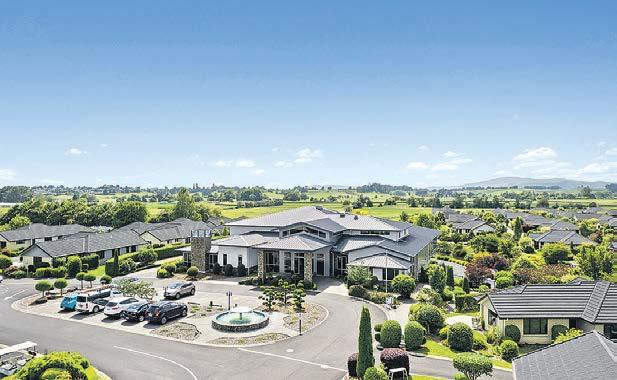


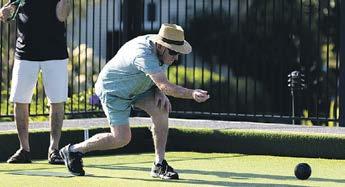
It’s Time to Experience Premium Independent Retirement Living
Family owned and operated, Te Awamutu’s Highfield Country Estate was established in 2012 and is set in beautifully landscaped grounds.
Commanding sensational views across to Mount Maungatautari, the village currently houses 116 two and three bedroom villas. Due to unprecedented demand, Highfield is proud to announce the limited release of an additional 50+ villas. Expansion has started with the earthwork construction underway. Future Highfield residents will soon be able to select from a variety of floorplans with the well appointed two and three bedroom properties featuring spacious, open plan living, coupled with quality fittings and appliances.
“The reality is that people living here enjoy it so much, they tell their friends, and we want to be able to offer the same lifestyle to more people,” explains Highfield General Manager, Sheryl Thomas.
Our Residents Enjoy the Benefits of:
•A family focused and dedicated Management Team
•Friendly, welcoming and supportive staff
• A comprehensive programme of weekly social outings, events and activities
•A safe and secure living environment
•Beautifully landscaped well-established and maintained grounds
•A vibrant community atmosphere and sense of belonging
•A focus on health, fitness and well-being
•Maintenance free, lifestyle living
“One of the best decisions we made was to move into Highfield, where we know, and our family knows, that we live in a safe, happy, and friendly environment where people look out for one another. We love living here and if you are lucky enough to get the opportunity to purchase a villa, please come and join us and enjoy our retirement.” – Dave & Shona Hollinshead
To learn more about the benefits of independent lifestyle living at Highfield and to organise a personalised tour of our facilities contact General Manager Sheryl Thomas – 07 871 2020 (Monday to Friday between the hours of 10am – 3pm) manager@highfieldcountryestate.co.nz | 397 Swarbrick Drive, Te Awamutu




Honey bees-ness tackled
By Chris Gardner
Local body moves to protect residents from showers of bee poo are being given a tick of approval by Mountain View Honey’s beekeeper Lindy Bennett.
Ōtorohanga District Council has included the guidance notes for beepers in the Otorohanga and Kāwhia townships in a planned revision of its Keeping of Stock, Poultry and Bees Bylaw.
“Honeybees going on orientation, foraging or cleaning flights often excrete after exiting the hive,” the guidance notes say.
“This can leave distinct trails of excrement within a 500-metre radius of the hive and can cause a nuisance to neighbours.”
Pirongia based Bennett keeps 50 hives across the Waikato and Bay of Plenty, and says it is great to see something being put in place to encourage responsible beekeeping in town — “especially as more people get interested in keeping a
hive or two in their backyard”.
Bee excrement is typically yellow to brown and can be hard to remove from clothing, vehicles and buildings.
The Ōtorohanga guidelines explain that hives can be repositioned on the property or rotated to provide flight paths in a direction away from neighbouring properties.
“Overall, the guidance notes look solid and cover the key things hobbyist beekeepers need to know,” Bennett said.
The draft revision to the bylaw’s guidance notes say honeybees can be encouraged to fly above head height if a flyway barrier, two or more metres tall, is placed near the hive entrance.
“It is important that flightpaths are not directed across public pathways on private and public land.”
Ōtorohanga regulatory and growth group manager Tony Quickfall told the June council

Photo: Chris Gardner
Cover story...
Hundreds of blankets, jumpers, hats and scarves were on display at the Cambridge Baptist Church last week before being packed up and shipped overseas in time for the European winter.
Operation Cover-Up (OCU) links with the Christian charity Mission Without Borders to send knitted blankets and clothes to children in orphanages and struggling communities in
meeting the beekeeping guidance notes were based on best practice from Waipā District Council which had engaged a subject matter expert some years ago.
Marianne Sager, of Gradara Avenue, Ōtorohanga, told The News she has resorted to cleaning bee poo from her windows daily
with a scraper in the height of the summer.
But she was philosophical with her lot, accepting that bee poo was the price paid for pollination and honey.
While her neighbour used to keep bees, he no longer did, and her windows still got dirtied by bees.
Consultation is open on what the council is now calling the Animal Nuisance Bylaw 2025 until August 8. The council will deliberate on submissions and decide on the final draft on August 26 before the new bylaw comes into effect in September.
The sky isn’t the limit for Blake...
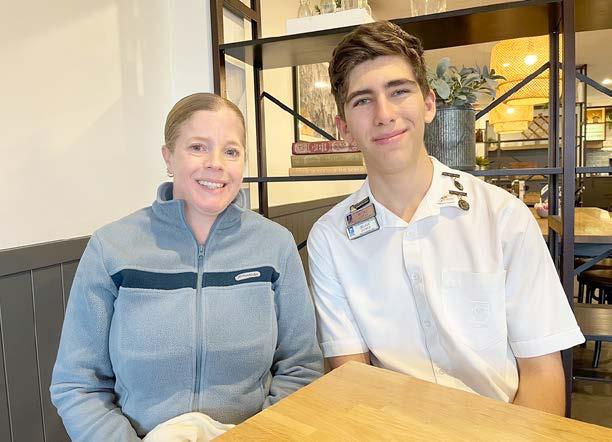
By Viv Posselt
A word among friends and a leg-up from Rotary might have propelled Blake Gower’s dreams of a future in aerospace engineering into the stratosphere.
The Te Awamutu College Year 13 student flies to London next week to attend the London International Youth Science Forum (LIYSF) at Imperial College. That opportunity, which came out of his participation in January’s Rotary National Science and Technology Forum 2025 in Auckland, will present him with access to some of the best scientific brains in the world and to an array of future study possibilities.
Airbus factory, both Oxford and Cambridge universities, go to lectures given by Nobelprizewinning scientists, and get stuck into debates and general knowledge competitions. Those bringing projects with them – Blake isn’t one of them – will be able to present them at a Science Bazaar and outside the formal stuff will be time for exploration.
Eastern European countries including Moldova, Romania, Ukraine, Bulgaria, Albania and Croatia.
OCU has been in New Zealand since 2000, and in Waipā, based in Cambridge from 2001.
Other knitting groups in the community, including those at rest homes and retirement villages, contribute to the annual haul of knitted goods.
“I am very, very excited,” he told The News last week. “I can say without exaggerating that the fortnight I spent at the Auckland Forum were the best two weeks of my life… there is something about being with over 160 like-minded people that is incredible. But this London thing… that was a big shock. Totally unexpected but a fantastic opportunity.”
If 160 had Blake fizzing, London will knock his socks off; expectations are for a longer forum with 500 attendees from 80 different countries.
While there, he will visit an
“We will have few free hours on a couple of days,” Blake said. He has already secured a ticket for MJ The Musical in the West End, and while he is not a total stranger to London (he has family living nearby) the city’s museums are on his radar. A tour of London is included, plus a visit to some of the normally closed-off sections of Buckingham Palace, with the Princess Royal Princess Anne in attendance.
He comes home on August 9, and is already booked for an early September ‘report-back’ to the Te Awamutu Rotary club. While Rotary has nothing to do with the London’s Youth Science Forum itself, it is Blake’s inclusion at the Rotary Auckland event that has enabled it all to happen.
Blake was the only Te Awamutu student sponsored by Te Awamutu Rotary for the 2025 Auckland Forum. How he got there was
through a conversation between his farmer dad Lance Gower, and someone known to the immediate past president of Te Awamutu Rotary, Kylie Brewer. With her own scientific bent embedded in agriculture, she mentioned that Blake might find the Auckland Forum a good opportunity to explore his science interests. It was that and much more. He got stuck into debating and general knowledge competitions and volleyball, as well as an Innovation Design Challenge (think Shark Tank). London popped up as one of those opportunities, and his parents Lance and Melissa Gower gave him the green light to apply.
The Korakonui-based student turned 17 in January, and has long been interested in science.
He is a deputy house captain at school, a debating captain, chairman of the SADD (Students against Dangerous Driving) committee, and wears numerous badges, some of them noting his exceptional academic performance.
He said the Rotary Forum had helped him settle on his preferred area of engineering and hopes to start his studies at Canterbury University.
After that, who knows, but London might just re-set his radar completely.
Lindy Bennett approves of bee keeping guidance notes for Ōtorohanga and Kāwhia beekeepers.
Immediate past president of Te Awamutu Rotary club, Kylie Brewer, with the Te Awamutu College student the club sponsored, Blake Gower.
Photo: Viv Posselt
Foster booked in for life
By Jesse Wood
Matthew Cooper, Chris Gibbes, Jono Gibbes, Scott McLeod and Deon Muir were among the rugby legends in attendance as Te Awamutu Sports ambushed Ian Foster with a life membership award.
Days after the June release of his autobiography, Leading Under Pressure, the former All Blacks coach came to speak to Te Awamutu Sports members and launch his book to the community.
Foster’s friends, family and club sponsors were all there to celebrate him – a wonderful opportunity to recognise the part he has played in Te Awamutu Sports’ history.
Foster has given a lot to Te Awamutu across 40 plus years as a player and supporter of the rural town, including coaching young players and holding a 2023 All Blacks squad naming at the club.
He is Waikato rugby’s most capped player - 148 games - a career that started at Te Awamutu Old Boys and then Te Awamutu Sports when it was born in 1990.
“He’s always kept giving back to the club. He brought that All Blacks squad naming to the club and we were fortunate enough to get given the All Blacks bench seat for the Waikato,” club president Mark McNaughten said.
“He’s always been around mentoring coaches and junior players. He never forgets where he’s come from, that’s quite rare these days.
“Ian was over the moon because he wasn’t
expecting the award.
“He had to do a book launch somewhere and he said to the publisher ‘there’s only one place I’m going to do this’ and it was at his rugby club - we thought that was pretty special.”
After playing his last matches for the Chiefs and Waikato in 1998, Foster’s coaching journey began alongside fellow Te Awamutu man Kiwi Searancke.
Foster’s book details contract issues, commercial disagreements and a deteriorating relationship with New Zealand Rugby.
After everything he has been through and learnt, for better or worse, Foster and Te Awamutu Sports have stood together.
Now he will be forever etched in the club’s history books, again. A member for life, and beyond.
“Ian has done a lot. What he has bought to the club in the service side is what he got him the life membership,” McNaughten said.
“He’s been up here coaching juniors; he’s made himself available through auctions and he speaks at Sports quite a bit. We’ve had sponsors nights and he always brings something along with him to auction. He’s a really good man.
“Apart from the fact too, he’s an All Blacks coach. When you look at his whole record outside of the club, where he’s been and where he’s got to was a bit of a factor as well.
“He’s given a lot back and he still is giving a lot back to rugby.”

Challenge gets harder for Sports
By Jesse Wood
Second-placed Hautapu will be well rested after a bye week, while Te Awamutu Sports’ 48-14 loss to Fraser Tech - pushed the Waikato club rugby finals further out of reach.
As the business end of the season draws near, Sports are sitting in seventh place, one point behind Ōtorohanga.
Captain Jake Russ scored Te Awamutu’s tries in the eight tries to two loss at Mill Street Park on Saturday.
Fullback Leo Scott and reserve Jaoquin Burke added a conversion each to round out the scoring.
Hautapu B also had a bye week, while Te Awamutu’s development side lost 71-14 to Fraser Tech B. Tech won 13 tries to two in muddy conditions. George Poolman and Dylan Jefferies slotted conversions for the visitors.
This weekend sees Hautapu venture into town to face Hamilton old Boys at Fred Jones Park, while Te Awamutu host Morrinsville.

Ōhaupō gave Morrinsville-based Kereone a 78-0 hiding in the division 1A championship.
Halfback Scott Thomas nipped around the rucks to score four tries as the club celebrated his brother Hayden’s 100th match.
In the division 1A Mooloo Shield, Leamington lost 17-12 to Tokoroa-based Southern United and Suburbs beat Pirongia 43-26.
Out of Waipā’s Division 1B teams, there was a win, a loss and a draw.
In the bottom five division, Ōhaupō B
pipped Kereone B 20-17.
Up in the top six competition, Pirongia B drew 12-all against their Suburbs counterparts at Flagstaff Park and Southern United B doubled Leamington B’s score 36-18 in Leamington.
Te Awamutu Sports were the only successful Waipā side in the under-21 competition, beating Leamington colts 21-17.
Hautapu were drubbed 66-5 by Hamilton Old Boys under-21 and Pirongia lost 43-24 against Morrinsville colts.

Foster at his rugby home, Te Awamutu Sports.
Photo: Justin Miezenbeek
Pirongia’s Liam Hobbs busts through the Suburbs defence.
Photo: Julie Gibson Kees Muller squares up a Fraser Tech B tackler.
Photo: Justin Miezenbeek


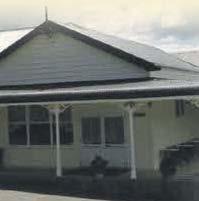

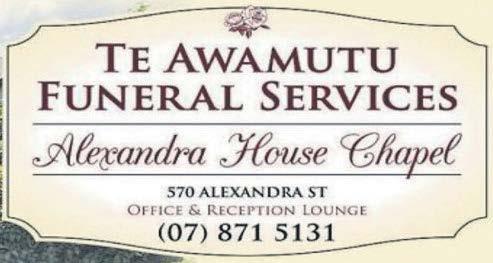


Across 1. Scour (5)
4. Junkie (6)
7. Flee (3)
8. Easy task (6)
9. Country (6)
10. Greasy (8)
12. Pong (4)
13. Accounts book (6)
Last week
19. Seasoned sausage (6) 20. Sensitive (6) 22. Whopper (3) 23. Taunt (6) 24. Giver (5)
1. Scapula (8,5) 2. Florid (3) 3. Musical note (5) 4. Irritated (7)
5. Cleansing agent (9) 6. Dance creator (13) 11. Ride on another person (9) 14. Cold-blooded creature (7)
Across: 1. Savage, 4. Acuity, 9. Ratio, 10. Nursery, 11. Athlete, 13. Late, 14. Overbalance, 17. Limp, 18. Alfalfa, 21. Biofuel, 22. Burnt, 24. Tether, 25. Weapon.
Down: 1. Streak, 2. Vat, 3. Gnome, 5. Corolla, 6. Identical, 7. Yo-yo, 8. Inseparable, 12. Have it out, 15. Rupture, 16. Carton, 19. Fable, 20. Abet, 23. Rip.




It’s family next for Petch
If the stars align, kiwi sprint cyclist Rebecca Petch will have a special new fan supporting her at the Los Angeles Olympic Games.
Petch and husband Jarrod Browning, who were married two and a half years ago, are expecting their first child later this year.
The Olympic silver medallist in the Team Sprint is planning a return to the track with her sights ultimately fixed on the Los Angeles Olympic Games in 2028.
It would make three Olympic Games for Petch, the multi-national champion in BMX qualified for the semifinals in that discipline at the Tokyo Olympic Games in 2021.
She was then approached to try track cycling, and has greatly enjoyed the challenge, forming a potent combination with teammates and friends Ellesse Andrews, Olivia King and Shaane Fulton.
With her background in the explosive sport of BMX, Petch has developed into a worldclass starter, with New Zealand team sprint team developing significantly after finishing third fastest at their Nations Cup event early in 2024. They produced stunning form at the Paris Olympic Games, breaking the world record in qualifying and ultimately won the silver medal.
“It is hard with sport because you put so much into it that you sacrifice other things in your life. Having a family is something that me and Jarrod talked about. We wanted to start a family but equally I do not want to give up sport,” said Petch.
In this respect Petch gained inspiration from two other Cambridge-based Olympians.
“Having a baby is exciting and scary as I don’t know how it will go, and just how things will work out going back to cycling. But I draw a lot of inspiration from Lucy

(Spoors) and Brooke (Francis) being so successful in rowing after childbirth. I knew I wanted to do that as well.”
Both Spoors and Francis had children, returning to rowing as busy mothers, and going on to win the gold medal in the double sculls at the Paris Olympic Games.
Petch and Browning are used to busy lives, starting their own business, Elite Spouting Services and investing significantly in the latest continuous guttering system machinery.
Previously Petch had run her own coffee cart operation, on top of the business and cycling duties. The “Little Petchy” coffee cart was a well-known and popular operation in Cambridge.
“I loved BMX and I did a lot of thinking before I decided to commit to track cycling. It was a big decision, but I have enjoyed it ever since. Now I know we have unfinished business all the way to Los Angeles.”
Petch is continuing to train and is tailoring her schedule during pregnancy. She has the full support from her teammates, coach Jon Andrews and Cycling New Zealand, especially around her desire to return to the sport after the birth of her child.
“My pregnancy is good timing this year as we only had one Nations Cup and the world championships is late in the year where I won’t be competing.
“Right now I am adapting my training as I need to, maintaining as much strength as I can but limiting any risk factors.
“Jarrod and I are excited for the future with our first child, the growth of our business and my cycling. It is going to be busy but exciting. We have our parents who are very excited and no doubt will be called on down the road.”











Rebecca Petch celebrated a silver medal at the Paris Olympics in 2024. Photo: SWPix








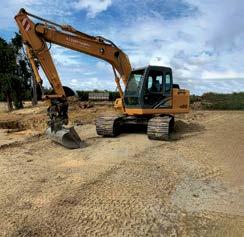


















•




By Jon Rawlinson
Three Ōtorohanga youngsters claiming a podium spot at Young Farmer of the Year’s AgriKids competition last weekend.
Held in Winton, near Invercargill, the AgriKids Grand Final saw top qualifiers from regional events take on a range of farmingrelated challenges.
Marlborough team, the Oinks, finished in first place and the King Country Stags, John Woodward, Isaac Wilson, and Jacob Bolt, all aged 12, were runners-up following a hardfought competition.
“It was pretty cool to finish second,” John Woodward said. “The quiz was pretty hard and so were a couple of the modules. It wasn’t as tough overall as it was last year, but it was a tough competition.”
The trio also competed in last year’s final but did not place.
While Jacob Bolt is home-schooled, his team mates attend Ōtewā School. Together, they competed against 20 other teams from throughout the country.
Beginning with a quiz, the youngest of the Young Farmer finalists then undertook modules covering various aspects of the primary industries. One of these involved driving a tractor.
Isaac said the module section was his favourite part of the competition, especially modules on TB and pests because he likes animals.
The final Race Off event engaged competitors in a quick-fire relay of agricultural activities including go-karting, solving a riddle and a three-legged race.
John wasn’t the only Woodward putting his farming skills to the test; his younger brother, Jack, 11, competed on the Young Guns team alongside Jacob’s sister, Brearna Bolt, 9, and Sam Blewett, 10.
John and Jack’s mum, Susie Woodward, said all six gave the competition their best shot. “It was really nice and they put in a lot of effort. They were really pleased that they were rewarded for that. Our other team, the





Otewa trio second in farmers’ test
Young Guns, didn’t make the top three, but we’re so proud of them too.”
Ōtewā School principal, Carolyn Pilton, was also pleased by her students’ efforts.
“They’ve all put in so much effort, so much training along the way. It was great to see them come away with second place this year – they really deserved it, it’s an amazing result.”
The annual Young Farmer of the Year contest yielded more winners. Representing the Waikato/Bay of Plenty region, Hugh Jackson was ‘over the moon’ on being named Young Farmer of the Year 2025.
“With this title, I really hope to help showcase the talent we have coming through
and highlight the opportunities that are there for young people,” he said. Jackson is sheep and beef farmer from Te Akau, north of Raglan.
A duo from North Canterbury’s Rangiora High School, John Lundy and Harry Parish, secured top honours in the In the Junior Young Farmers class.
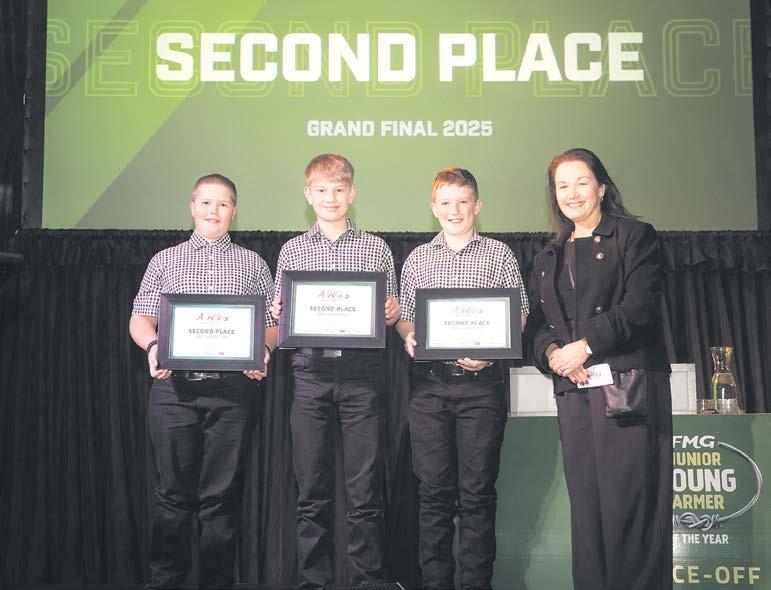
On the podium – form left, Jacob Bolt, John Woodward and Isaac Wilson with NZ Young Farmers’ Lynda Coppersmith.
Garage Sale
Saturday, 12 July




Te Awamutu Bowling Club 384 Bank Street 8.30am start
Wide variety of indoor and outdoor household items for sale. Eftpos available. Ph. 021 052 7771






FIREWOOD for sale – Dry shed stored gum, lawson, mac mix. $110 per cube, delivery included. Ph or Txt 027 540 1754.


TE AWAMUTU CONTINUING EDUCATION
Wednesday 16thJuly2025 10am
Speaker: Mintie
Topic: Radio Host Graham Mead Sportscommentatorfor nearly30yearsandlead radiocommentatoroutof FMGStadium


MOORBY, Erana Theresa – Passed away far too soon at Waikato Hospital on Sunday, 6th July 2025, aged 46 years. Dearly loved mum of Leon, and treasured daughter of Sheryl-Lee. Much loved niece of Rene & Lynella, and Shane. Cherished granddaughter of the late Lisa & Len Taylor (Te Puke). At Erana's request a private farewell has taken place. Messages to the Moorby Family can be sent c/- 262 Ohaupo Road, Te Awamutu 3800 or in Erana's online tribute book at www. rosetown.co.nz.

DEMUS, Phyllis Esma (Phil)
– Passed away peacefully at Radius Windsor Court Hospital on Saturday, 5th July 2025, aged 82 years. Cherished mother and mother-in-law of Shane, Mark, and Scott & Kay. Much loved Gran of Jordan, Ryan, Esmae, and Granny to Ashleigh. Heartfelt thanks to the wonderful staff at Radius Windsor Court Hospital for their care and kindness to Phil over the past four months. A private celebration of Phil's life has taken place. Messages to the Demus Family can be sent c/- 262 Ohaupo Road, Te Awamutu 3800 or shared in Phil’s online tribute book at www.rosetown.co.nz.







MILK TRUCK Driver Wanted. Must have current HT licence, option to include work on farm. Ph Mark Bocock 027 474 6917
TE AWAMUTU EVENT CENTRE CAFÉ –REQUEST EXPRESSION OF INTEREST BUSINESS OPPORTUNITY!
The Waipa Community Facilities Trust (GoWaipa) is seeking responses from suitably experienced parties who are interested in taking on the lease at the Te Awamutu Event Centre
The term of the lease is for 3 years, with a 3 year right of renewal. Further details of the opportunity and the requirements for parties interested in submitting an Expression of Interest are contained in the Request For Proposal document which is available from Te Awamutu Event Centre reception or via email request gowaipa@gowaipa.com.
Expressions of Interest close 4:00pm on Friday 25th July 2025. Expressions of Interest are to be posted to the Te Awamutu Event Centre –Reception, 3 Selwyn Lane, Te Awamutu 3800 or by email at gowaipa@gowaipa.com
TE AWAMUTU EVENTS CENTRE


WAIPA DISTRICT COUNCIL MEETING NOTICES

The following meeting will be held in July 2025: Monday, July 21,
All meeting information and electronic copies of Council agendas are available at waipadc.govt.nz/agendasandminutes
Steph O’Sullivan Chief Executive



REVELL, Sean Peter –1981 – 2025. As a result of an accident, on Monday, June 30, 2025, aged 44 years. Loved fiancé of Beah. Loved father to the three musketeers Troy, Daniel and Leo, and special friend of Millie. Treasured son of Sylvia and the late Pedro. Much loved brother and brother-in-law to Jason & Kerrianne, Maggie & Greg, Peta-Maree the late Daniel. Uncle to Arlo. A service to celebrate Sean’s life has been held. Messages to the Revell Family can be sent C/- 262 Ohaupo Road, Te Awamutu 3800 or in Sean’s online tribute book at www. rosetown.co.nz
“Missed and loved, H.F.M.” “Fisherman at heart”

TERVIT, Suzanne – Passed away peacefully at C.H.T, Te Awamutu on June 26, 2025, aged 77 years. Best mate of Barry for over 60 years and much-loved wife for 57 of those years. Loved mother and friend of Linda and Richard, Dean and Adele. Loved sister of Jan and George. Treasured grandmother of seven and great grandmother of four. A patient sufferer at rest. Thanks go to St Johns and OPR unit at Waikato Hospital. A special thanks to CHT management and staff at Te Awamutu for their devoted care of Sue. Thanks to doctors and staff at Te Awamutu Medical Centre for their attendance to Sue. Thank you to family and friends for the visits, care and flowers. A service has been held. All communications please to the Tervit family, PO Box 137, Te Awamutu 3840.
Te Awamutu Funeral Services, FDANZ




Jordan Goss Funeral Director
Ohaupo Road, Te Awamutu

































